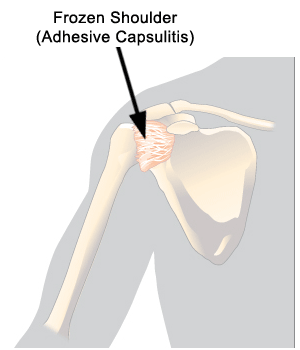Medical Library
Adhesive Capsulitis

Adhesive Capsulitis, or a frozen shoulder, is a poorly understood condition in which the deepest layers of soft tissue, called the joint capsule, become diseased. Shoulder range of motion becomes very limited and painful. The cause of a frozen shoulder is still not known but minor traumas, hyperthyroidism, diabetes, psychiatric patients, post-surgical patients, and prolonged immobilization of the shoulder may in someway cause this condition. The disease is characterized as having freezing, frozen, and thawing stages, and is self-limiting (in time it goes away on its own). However, it can take two years or more to recover from this condition.
Physical therapy consisting of patient education, stretching, joint mobilization, and a home exercise program can help speed recovery. For a small percentage of frozen shoulder patients, it may take two years or more to recover.
Possible Treatments
- Active Assistive Range of Motion Video
- Cryotherapy or Cold Therapy Video
- Electrotherapeutic Modalities
- Heat Pack Video
- Isometric Exercise Video
- Proprioceptive Neuromuscular Facilitation (PNF) Video
- Posture Training Video
- Physical Agents
- Shoulder Active Range of Motion Video
- Shoulder Joint Mobilization Video
- Shoulder Passive Range of Motion Video
- Shoulder Resistive Range of Motion Video
- Soft Tissue Mobilization Video
- Stretching/Flexibility Exercise Video
- Active Assistive Range of Motion
Possible Treatment Goals
- Decrease Risk of Reoccurrence
- Improve Function
- Improve Muscle Strength and Power
- Increase Oxygen to Tissues
- Improve Proprioception
- Improve Range of Motion
- Improve Relaxation
- Self-care of Symptoms
Additional Resources
Shoulder Articles
Pick a Body Area
Other Choices
Systemic Treatments Exercises For Physicians NewslettersDisclaimer
The information in this medical library is intended for informational and educational purposes only and in no way should be taken to be the provision or practice of physical therapy, medical, or professional healthcare advice or services. The information should not be considered complete or exhaustive and should not be used for diagnostic or treatment purposes without first consulting with your physical therapist, occupational therapist, physician or other healthcare provider. The owners of this website accept no responsibility for the misuse of information contained within this website.
